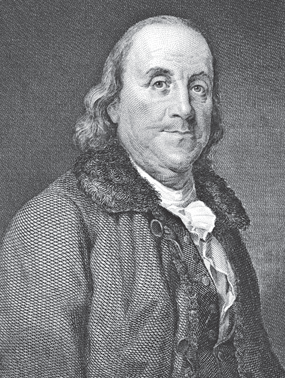One of the first Americans to make major contributions to science, Benjamin Franklin (1706–1790) was known for his quick wit, support for the American Revolution, and influential experiments with electricity. He also invented scores of devices, including bifocal lenses, the lightning rod, and the Franklin stove. His inventions, coupled with his puckish personality, made him an international celebrity—the embodiment of the nation he helped to found.

Born in Boston, Franklin was apprenticed to his brother, a newspaper publisher, as a teenager. He soon tired of his brother’s mistreatment and fled to Philadelphia, where he founded his own newspaper and eventually earned his fortune.
Franklin’s financial success gave him the opportunity to begin dabbling in science and politics. After retiring from the printing business in 1748, he began his own experiments with electricity, publishing a paper in 1750 that theorized that lightning was a form of electricity.
In the paper, Franklin described his famous experiment with a kite. If the kite was struck by a bolt of lightning, he theorized, the charge would be transmitted through the string to the ground, proving that lightning was a form of electricity. There is no evidence that Franklin ever actually carried out the experiment as he described it in the paper—indeed, such an exercise could easily have been fatal.
Franklin was sent to England in 1757 to represent the Pennsylvania legislature in London. He remained in England for most of the next two decades, serving as an ambassador for the increasingly restive colonies. He returned in 1775, just after the outbreak of war, and was a signer of the Declaration of Independence in 1776.
Congress soon dispatched Franklin to Paris, where his scientific fame helped him coax the French government into aiding the colonies. In the last years of his life, Franklin completed his autobiography and wrote articles criticizing slavery. He died in Philadelphia at age eighty-four.
ADDITIONAL FACTS
- In his will, Franklin left the cities of Philadelphia and Boston 1,000 pounds sterling each, on the condition that the money be allowed to gather interest for 200 years before it was spent. By the 1990s, when the 200-year mark passed, the trusts were each worth millions of dollars.
- Do not fly a kite in a thunderstorm. Several imitators, under the impression that Franklin had safely carried out the test as described in his paper, have been electrocuted trying to replicate his experiment.
- Franklin’s first lightning rods were installed at two Philadelphia landmarks: the Pennsylvania State House, now known as Independence Hall, and the steeple atop Christ Church.
